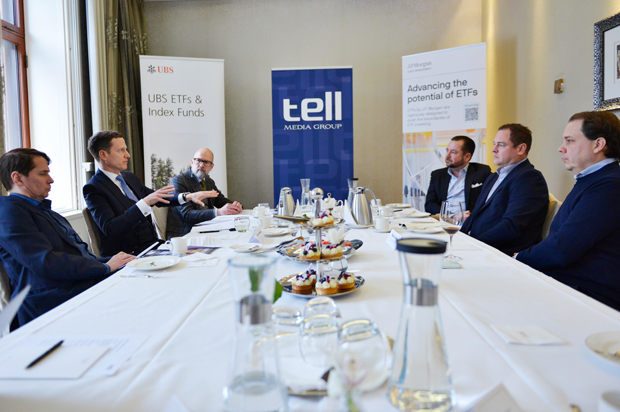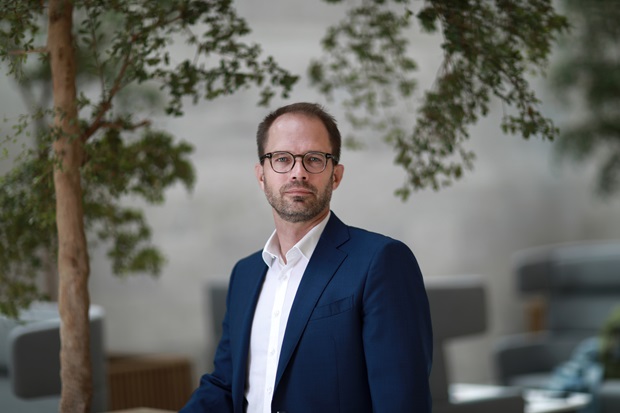
Active ETFs, thematic exposures and ESG innovation needs
Earlier this year, Tell Media Group, in co-operation with JPMorgan Asset Management and UBS Asset Management, invited Finnish investors to discuss trends within the ETF industry at Hotel Kämp in central Helsinki.
The discussion started with Niklas Tell asking the investors to highlight some of the main reasons for using ETFs.
CAROLUS REINCKE: “There are some obvious reasons, such as the diverse universe of ETFs, easy access and administration. Also, if you look at actively managed funds versus ETFs, then I view actively managed funds basically as style funds. As an allocator, you need to recognise the style of the individual manager and evaluate how that style works in different market conditions. Alternatively, you can buy style ETFs directly and that’s what we typically do.”
FLORIAN CISANA: “How would you define a style ETF?”
CAROLUS REINCKE: “I’m talking about style factors such as value, growth and momentum etc.”
MIKAEL LÖFBERG: “It’s very similar for us. Transparency is key and it makes it very straightforward when you’re doing the asset allocation. You can instantly look up the top holdings in your portfolio and that’s very helpful. The quick execution is also a plus, even if we’re not traders that change our holdings very often. We must of course also mention that ETFs are cost efficient and that’s helpful for the overall cost of a mandate because we’re also using active funds.”
MARKO ALARAATIKKA: “We have a range of internally managed active funds and we use ETFs to fill the gaps when we’re building portfolios. We’ve been using factor ETFs, which Carolus mentioned as well, and during the last couple of years we’ve also looked at different themes, such as technology, electric vehicles, global water and robotics.”
NIKLAS TELL: IS THERE ANYTHING YOU’RE CURRENTLY MISSING FROM THE ETF UNIVERSE?
MIKAEL LÖFBERG: “There are some segments, especially in fixed income and credit. One example would be Nordic corporate bonds, which we do via active managers. Another example would be European leveraged loans. When it comes to equities, our home market of Finland and the Nordic region have been one of the worst performing and we’ve been staying out of it. However, we started to allocate to Nordic small caps at the end of last year and here we also used active managers.”
CAROLUS REINCKE: “If emerging markets would become interesting given that they’re very concentrated and heterogeneous markets, it would probably make sense to use an active manager. I agree that the leverage loans space and the whole credit space is dominated by active managers for a reason. I do, however, believe that we will see more innovation in the credit space. I also think it’s worth highlighting sustainability, which is linked to what Mikael mentioned regarding transparency. It’s easier to implement a sustainable strategy using transparent vehicles such as ETFs rather than a vehicle that has a human layer to it. We’ve seen this among pension funds in Finland that have been investing in sustainable ETFs.”
FLORIAN CISANA: “What you say echoes a lot of what we hear from our clients. Many of the positive features of ETFs are also valid for index funds. I do, however, believe that an ETF is superior to an index fund when it comes to intraday pricing and tradability, regardless of whether it’s active or passive. Now, we don’t have active ETFs at UBS but we see in particular in the US that the ETF wrapper is used more and more for active funds. I also think that further regulatory changes in Europe, and in particular in the Nordics, will further increase the demand for both active and passive ETFs.”
THOMAS STEPHENS: “We very much focus on ETFs as a delivery mechanism of client outcomes, irrespective of the investment focus on emerging markets or different sectors. ETFs are the technology. Indexation and passive investing have been synonymous with ETFs historically but we’ve moved past that as the active ETF offering is far broader today.”
The roundtable discussion was published in the Nordic ETF Trends supplement (scroll down to find all supplements and reports), distributed with issue 02, 2023 of Nordic Fund Selection Journal. A PDF of the complete story can be found here.
//Participants
- MIKAEL LÖFBERG, Chief investment officer at Capman Wealth
- MARKO ALARAATIKKA, Senior portfolio manager at S-Pankki
- CAROLUS REINCKE, Chief investment officer at Forea Family Office
- THOMAS STEPHENS, Global co-head of ETF Capital Markets at JPMorgan Asset Management
- FLORIAN CISANA, Head UBS ETF & index fund Nordics, France and MEA at UBS Asset Management



